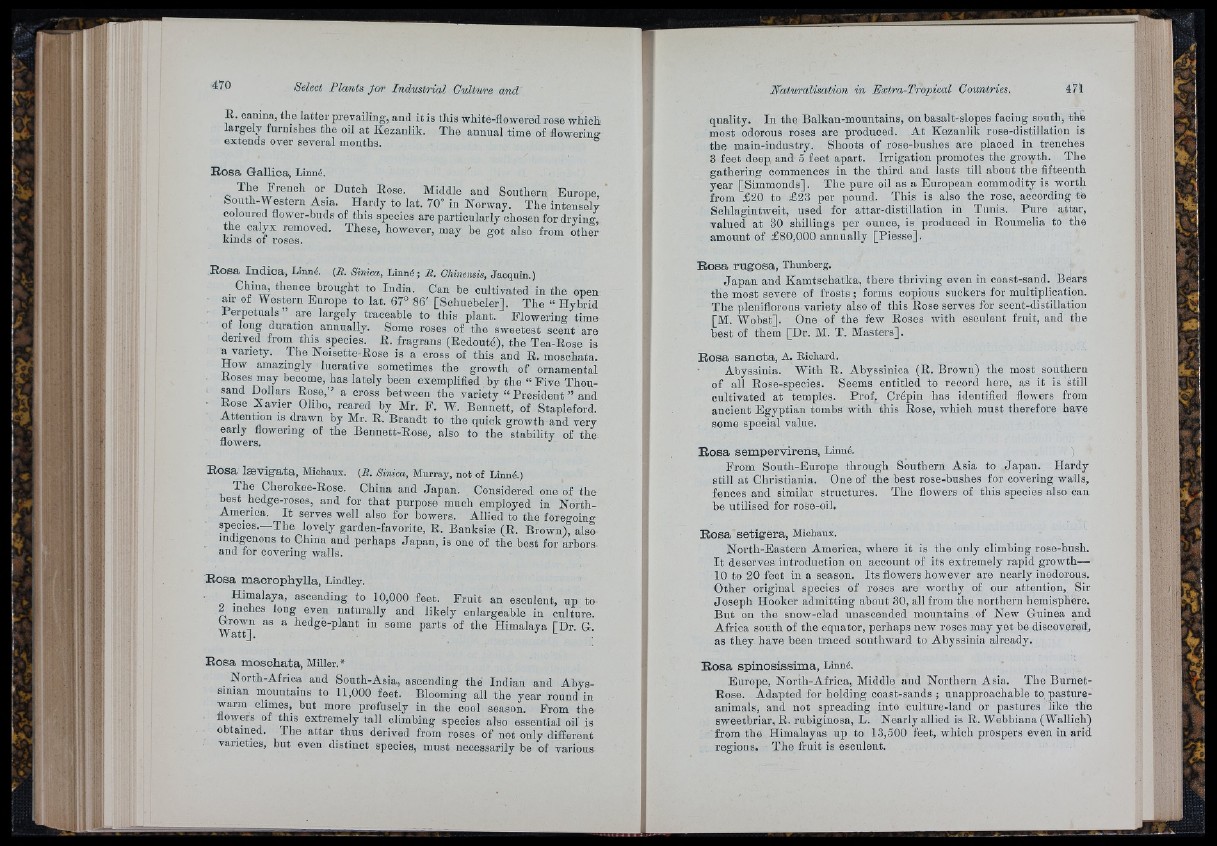
I( E
E . eamna, the latter prevailing, aud it is this white-flowered rose which
largely furnishes the oil at Kezanlik. The annnal time of flowering
extends over several months.
Eosa Gallica, Linné.
The French or Dutch Rose. Middle aud Southern Europe,
South-Western Asia. Hardy to lat. 70° in Norway. The intensely
coloured flower-buds of this species are particularly chosen for drying,
the calyx removed. These, however, may be got also from other
kinds of roses.
Rosa Indica, Linné. (R. Sínica, Linné; R. Chinensis, Jacquin.)
■ brought to India. Can be cultivated in the open
■ air of Western Europe to lat. 67° 86' [Schuebeler]. The “ Hybrid
P e rp e tu á is” are largely traceable to this plant. Flowering time
of long duration annually. Some roses of the sweetest scent are
derived from this species. R. fragrans (Redouté), the Tea-Rose is
a variety. The Noisette-Eose is a cross of this and R. moschata.
How amazingly lucrative sometimes the growth of ornamental
Roses may become, has lately been exemplified by th e “ Five Thou-
^ n d Dollars Rose,” a cross between the variety “ President ” and
■ Rose Xavier Olibo, reared by Mr. F. WL Bennett, of Stapleford.
Attention is drawn by Mr. R. Brandt to the quick growth and very
early flowering of the Bennett-Rose, also to the stability of the
liowers.
Rosa lævigata, Michaux. (R. Sinica, Murray, not of Linné.)
The Cherokee-Rose. China and Japan. Considered one of the
best hedge-roses, and for th a t purpose much employed in North-
Amenca. I t serves well also for bowers. Allied to the foregoing
species.—The lovely garden-favorite, R. Banksiæ (E . Brown), also
indigenous to China aud perhaps Japan, is one of the best for arbors
and for covering walls.
Rosa macrophylla, Lindley.
Himaiaya, ascending to 10,000 feet. F ru it an esculent, up to
2 mches long even naturally aud likely eniargeable in culture.
w T t l f ^ hedge-plant in some parts of the Himalaya [Dr. G.
Rosa moschata, Miller.*
North-Africa and South-Asia, ascending thé Indian and Abyssinian
mountains to 11,000 feet. Blooming all the year round in
warm climes, hut more profusely in the cool season. From the
flowers of this extremely tall climbing species also essential oil is
obtained. The attar thus derived from roses of not only different
varieties, but even distinct species, must necessarily be of various
quality. In the Balkan-mountains, on hasalt-slopes facing south, the
most odorous roses are produced. At Kezanlik rose-distillation is
the main-industry. Shoots of rose-bushes are placed in trenches
3 feet deep and 5 feet apart. Irrigation promotes the growth. The
gathering commences in the third and lasts till about the fifteenth
year [Simmonds]. The pure oil as a European commodity is worth
from £20 to £23 per ponnd. This is also the rose, according to
Schlagintweit, used for attar-distillation in Tunis. Pure attar,
valued at 30 shillings per ounce, is produced in Eoumelia to the
amount of £80,000 annually [Piesse].
Eosa rugosa, Thunberg.
Jap an and Kamtschatka, there thriving even in coast-sand. Bears
the most severe of frosts ; forms copious suckers for multiplication.
The pleniflorons variety also of this Rose serves for scent-distillation
[M. Wobst], One of the few Roses with esculent fruit, and the
best of them [Dr. M. T. Masters].
Eosa sancta, A. Richard.
Abyssinia. With R. Abyssinica (E. Brown) the most southern
of all Rose-species. Seems entitled to record here, as it is still
cultivated at temples. Prof. Crépin has identified flowers from
ancient Egyptian tombs with this Rose, which must therefore have
some special value.
Rosa sempervirens, Linné. ;
From South-Europe through Southern Asia to Japan. Hardy
still at Christiania. One of the best rose-bushes for covering walls,
fences and similar structures. The flowers of this species also can
he utilised for rose-oil.
Eosa setigera, Michaux.
North-Eastern America, where it is the only climbing rose-bush.
I t deserves introduction on account of its extremely rapid growth—
10 to 20 feet in a season. Its flowers however are nearly inodorous.
Other original species of roses are worthy of our attention. Sir
Joseph Hooker admitting about 30, all from the northern hemisphere.
But on the snow-clad unascended mountains , of New Guinea and
Africa south of the equator, perhaps new roses may yet be discovered,
as they have been traced southward to Abyssinia already.
Eosa spinosissima, Linné.
Europe, North-Africa, Middle and Northern Asia. The Burnet-
Rose. Adapted for holding coast-sands ; unapproacliahle to pastnrs-
animals, and not spreading into oulture-land or pastures like the
sweetbriar, R. rubiginosa, L. Nearly allied is R. Webbiana (Wallich)
from the Himalayas up to 13,500 feet, which prospers even in arid
regions. The fruit is escnlent.